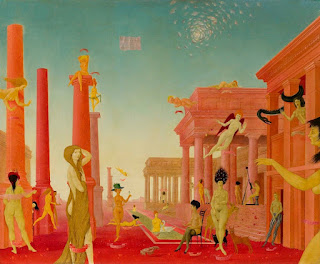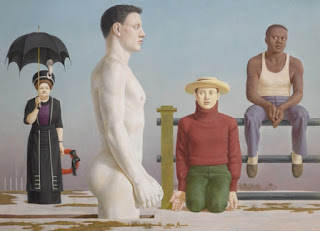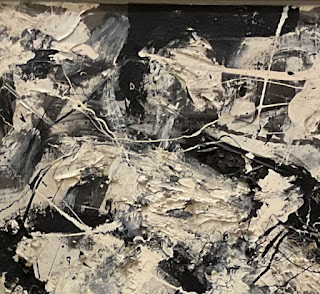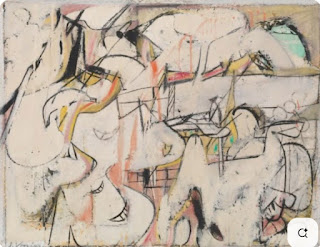This is Chapter 5 of David Anfam’s “Abstract Expressionism” : The Process of Painting
Clyfford Still, PH-384, 1946, 62 x 44
In the last chapter, Clyfford Still’s “Quicksilver” exemplified the ideographic picture - and now the above piece by the same artist is shown to exemplify the “process of painting”.
But I’m not feeling a whole lot of difference between them. They’re both like natural phenomena stamped with the artist’s identity : melancholy, heavy, looming, jagged, indomitable. They belong on the walls of a secluded Buddhist monastery high in the rugged mountains. I’d like to visit from time to time, but could not live with them/him.
Quite possibly someone could - or maybe already has -
worked these visual elements with more power and beauty,
but the art market, as it is,
would reject that as derivative.
Still perfected the nakedly physical involvement in process that Motherwell foresaw. His 1946 PH-384 has the mastery of touch that fuses every knife-stroke, each colour chosen from an earth-toned palette, into an organic mosaic of pigment.“Nakedly physical involvement”? As Anfam notes later in the chapter, the Impressionist painters are known for that. Earlier examples can also be found where the process of painting has not been concealed. Yet in all of them, aren’t some other effects far more important?

Two Figures, 1936, PH-726
It builds upon much earlier compositional types where twin protagonists, sometimes intertwined (as in PH-726 though here separate, stand against a background. Only now the duality is pared to two snaking verticals landlocked in a fastness of umbers and sienna. The life' of the whole (also a favourite metaphor of Still's) resides in the ridges, smears and fissures of paint which catch the light. This erodes distinctions between figure and ground although the tonal contrasts emphasize them. The resultant space, if that word justly describes a flat yet manifold surface, exudes tension. We want to penetrate its inscrutable structuring but are prevented by the sheer tactility.
Regrettably, tactility cannot be felt on my computer screen images.
( and thank God Still stopped painting human figures. )
Unlike Impressionism or Cubism, Abstract Expressionism was not a style or a movement. What the five pioneers had in common was not a shared aesthetic, a painting technique, or a manifesto but a sense of the overwhelming importance of art, a bedrock belief in the power of painting to address ideas and emotions at the deepest level.
Richard Dorment, 2016
The above is a review of an historic ABX exhibition curated by Anfam. I certainly agree that ABX. is neither a style nor a movement. I would call it a marketing/promotional event. Please note that a “bedrock belief in the power etc” is not to assert that any of these paintings actually has any such powers. Dorment made no such claim - and neither would I.
Though the Abstract Expressionists always resisted a single collective identity based on style, theories or social ties, they came closest to an avant-garde nucleus between the end of the War and 1950-51. By then a complex network of friendships and acquaintances had meshed.
It’s a nucleus of recognized brands - like the rack of popular magazines near the check out counter of a grocery store.
Some began long before, like the meeting of Guston and Pollock at their Los Angeles high school in 1927; others arose late and casually as when Kline built a studio partition for Tomlin and Guston in 1949; or else passing contacts, like Rothko's with Still in Berkeley in 1943, matured into a deeper rapport. More superficial signs of cohesion were the popular meeting-places in Greenwich Village that included the Waldorf Cafeteria and then the Cedar Tavern. The Club, a loose-knit artists' discussion group, was likewise founded in
1949. A year earlier Still, Rothko, Motherwell, Newman, Baziotes and the surréalisant sculptor David Hare each played some part in establishing the Subjects of the Artist, a short-lived school intended to reaffirm meanings in abstract art. In 1947 Rosenberg edited with Motherwell the single issue of Possibilities magazine which contained statements by several painters and Smith.
Another periodical featuring their work and views, Tiger's Eye, appeared then and ran through nine issues.
Interest from dealers, critics and the media also exerted an external shaping influence. The New Yorker critic Robert Coates's description of Hofmann's paintings as belonging to
'abstract expressionism' was merely one of several attempts to label what appeared a new tendency. Given America's postwar prosperity compared with the economic and cultural exhaustion of Europe, its art market could be expected to capitalize on these circumstances and once Guggenheim returned to Venice in 1947 her role was more than fulfilled by the ambitious younger dealers Betty Parsons, Charles Egan and Samuel Kootz. Their New York galleries showed every major figure, from Motherwell at Kootz in 1946 to Krasner with Parsons in 1951, plus solo débuts for Siskind (1947) and de Kooning (1948) under Egan, while Smith exhibited at Marion Willard's gallery. Though support from public institutions lagged slightly behind, MoMA's '15 Americans' of 1952 (incorporating Pollock, Rothko and Still) announced the rise of high-level policies which would gain international fame for the movement by the end of the decade. On the whole the promotion of Abstract Expressionism entailed its stereotyping. It could hardly have been otherwise in the climate of the Truman and Eisenhower years.
America moved so far rightward after the Second World War that the 1945-60 era has been called 'The American Inquisition' and a time of 'The Great Fear' when conformity reigned, hysteria over the supposed threat of Communism was pandemic and surveillance or repression pervaded the fabric of culture. McCarthyism and the Cold War represented only the most visible symptoms of this far subtler totalitarianism than Russia's, which the novelist Ken Kesey symbolized retrospectively as the authoritarian insane asylum of One Flew Over the Cuckoo's Nest (1962). Furthermore, although contemporary liberals such as the Columbia University philosopher Sidney Hook and Arthur Schlesinger Jr in his The Vital Center (1949) purportedly denounced extremism, their rhetoric served to mask the dominant and itself extreme conservative ethos; Hook's willingness to side with McCarthy's denial of civil liberties was but one of many traits that put this liberalism' under quotation marks.
Controversy still surrounds the reading of Abstract Expressionism against this reactionary context. Neither an obviously partisan nor a monolithic response, it has subtle yet pervasive features calculated to transcend and contravene the political tenor of the times. We might expect this from the stances of the creators themselves. On personal terms they felt beleaguered, at odds with the establishment, or both, and as opposed to some of their earliest supporters, such as erstwhile leftist intellectuals like Greenberg, no evidence has yet associated them with Cold War ideals. Instead, the Stalinist Gorky deplored America's 'commercial philistinism' and inhumanity while Reinhardt risked contributing to an openly Communist publication as late as 1947 when Motherwell and Rosenberg alluded in Possibilities to how 'the deadly political situation exerts an enormous pressure. Open dissent had become impractical and Still acknowledged this with a notion of art as a kind of guerilla warfare. Smith's leftist beliefs can be gauged by his declared identification in 1948 with working men' and Local 2054 United Steel Workers of America. This came a year after the repressive. the Taft-Hartley Act. Both New damning remarks about their country’s atom bomb was almost ubiquitously praised) : asked to explain the meaning of of one of his works. If properly read, Newman answered, “ it would mean the end of all state capitalism. For Still, the United States had bred a totalitarian mentality. To discover Cold War liberal ethics behind such positions, as Serge Guilbaut and others have done, seems at best misleading.
On the whole the promotion of Abstract Expressionism entailed its stereotyping. It could hardly have been otherwise in the climate of the Truman and Eisenhower years. Should how art was promoted in its day have any affect on how it feels ? Even back then - shouldn’t promotion have been ignored except by scholars of marketing? I do wonder why Anfam did not mention how the CIA used ABX to promote Americanism,
Edwin Dickinson. 1891-1978, Self portrait in Fur Hat, 1914
Anfam introduces us to some figure painters who did not go abstract.
Still Life, 1914
Nude, 1937
Studio Wellfleet, 1947
Edwin Dickinson, 1948
Self Portrait, 1949
1951
Dickinson interested me more when he was barely 20.
Henry Koerner, 1915 - 1991 , Mirror of Life, 1946
John Wilde (1919-2006), “More Festivities at the Palazzo Sanseverini,” 1951-52, oil on wood panel, 20 1/8 x 24 3/8
I love the wacky classical world of John Wilde, a midwesterner who lived in Wisconsin. What a great painter he would have been 500 years ago.
Jared French, 1905- 1988, The Double, c. 1950, 25 x31
What does belong more to the moment is their turning
inwards upon the processes of making art. Introversion had become commonplace by then as many writers and intellectuals retreated from the alarming or hostile political scene. A penchant for fantasy arose in the Southern Gothic novels of Eudora Welty and Truman Capote as well as in the arcane dreamlike compositions painted by Edwin Dickinson, Jared French, John Wilde and Henry Koerner.
I do see a “penchant for fantasy” in Koerner, Wilde, and French —- but definitely not in Dickinson.
And I do not consider a focus on “the processes of making art” to be introversion.
Concurrently a spectrum of existential issues involving selfhood, isolation and psychic malaise came to prominence. Yet whether in the fiction of Bellow, Bernard Malamud and J. D. Salinger, the early poetry by Theodore Roethke and Robert Lowell, or the drily precise pictorial idioms of Andrew Wyeth, Bernard Perlin, George Tooker and Paul Cadmus, these again proved stylistically conservative.
It seems so odd to group Wyeth together with those early creators of Gay identity art ( Jared French is another) - but “drily precise” does seem to fit them all.
Against these tendencies Abstract Expressionism effected a bold synthesis. It combined existential content and innovatory handling without a retreat into the ivory tower of form-for-form's-sake. Instead, such developments of the later 1940s as very large formats, stark or saturated colour and a stress on the medium itself were ways to engage the spectator and even provoke a challenging gut reaction. This was highly extreme art when the dangers of extremism - political and aesthetic - were widely and loudly decried.
Even the withdrawal to the solitudes of studio and countryside (Gorky went to rural Virginia and Connecticut, Pollock moved to a Long Island farmhouse in 1945, and Smith and Guston settled in upstate New York) had a double edge.
There they could attain a stylistic audacity that left most contemporary realisms looking artificial and out of date. In Manhattan's urban congeries de Kooning and Kline found a similar edgy intensity, which also gripped Siskind's work as well.
A spirited presentation of ABX apologetics - even if it's a spectacle aesthetic - like that of the Roman colosseum.
…. To create outside or at the edge of society during the Cold War provided an escape from consensus and conformity. Furthermore, an outburst of anti-modernism erupted during 1947-49. As Life carefully derided Pollock's methods, the Boston Institute of Modern Art switched its titular 'modern' to 'contemporary' and Senator George Dondero denounced non-academic twentieth-century painting as Communist subversion, so abstraction once again acquired the radical aura that it had held for a previous generation. Its originality now, however, was centred upon the Abstract Expressionists' physical exploitation of their materials.
At least since the famed passage in Leonardo's Treatise on
Painting (first published in 165l) urging the discovery of subjects in random stains on walls, inspiration has been linked to directness and methods to transform felt experience into visual fact. In part the course of Western painting itself entails changing conventions to meet this end, from the control of illusionism in, say, Van Eyck, where the picture plane approximates a window (and thus offers instant access to the depicted scene) to the very different instantaneity of Monet which depends more on the freshness of painterly mark-making. Both worlds are vividly felt but how we apprehend that vividness depends on the rules whereby vision is reorganized upon a flat surface. For another analogy we might compare a name printed in Gothic lettering to one impetuouslyh signed: the latter bears an especially close relation to its maker of a kind that semioticians call 'indexical' and has ambiguities and a pulse absent from the formalized Gothic script. Magnified to historical proportions, it was an analogous changeover that happened during the 1940s. The mimetic rendition of symbols (early 1940s) was phased into stark signs (mid-1940s) and eventually the indexical registering of traces (later 1940s). This progression was clearest in painting (though always mutable and its successive stages merged) but despite the technical obstacles to such directness in sculpture, Smith's attitude changed until by the early 1950s his erstwhile graphic symbolism and solid cast shapes modulated to the subtle forcefulness of the welded steel line or plane suspended in space [127]. Equally, Siskind's photographs tended to replace objects with shadows, imprints, outbursts and other indexical effects [86]. Since everything in the transition just described hinges upon those points where the artist's actions encounter our response - namely the picture
plane and surface - their role was also transformed until Pollock's 1947-50 paintings centrifugally explode a hitherto shallow space and in de Kooning's Excavation terrific pressures bear down upon the contents of the image.
Willem De Kooning, Excavation, 1950
“Terrific pressures bearing down on the image “? That never occurred to me - I’ve felt more like everything in the image was stressed - nearly rubbed out. But neither accounts for the graphic intensity that makes this piece special.
********
At this point, I will skip most of the chapter that follows.
As Anfam pointed out at the very beginning, the ABX painters had very little in common - but despite that, he went on hunting for it - jumping ever more quickly from one artist and one idea to another - as if the reader is supposed to nod in agreement rather than reflect. This is hardly rare in the world of art talk - but this is the first time it’s appeared in this book.
A focus on “the process of painting” really only seems to apply to Pollock and DeKooning around 1950 - so that is the only discussion that I will address.
Jackson Pollock, Lavender Mist, 1950
Feels as impersonal as the night sky or bacteria on a petri dish.
The tense, seething undertone of an unfriendly universe
with a sense of order just beyond comprehension.
Something like an aerial view of a great city
as seen through clouds and smoke.
Detail
Pollock, Greyed Rainbow, 1953, detail
Here’s a detail from a piece in Chicago.
Looks like decaying leaf litter on the forest floor. The more I look at it, the more my skin begins to itch.
>
Never had painting been so far from the compositional hierarchies, perspective and figure-ground relations that go back to the Renaissance --it's the figure-ground relations that can't be found in mainstream Western Art ( it does appear elsewhere - for example: faux marble decoration). The marks, drips, and lines do appear against a background - but they never serve as the edges of an enclosed shape.
>Pollock's apocalyptic grandeur breaks with their minor-key Orientalism as well as the quietist or existential gloom that had become fashionable on both sides of the Atlantic. - I see both gloom and grandeur here - or, perhaps the better word is "grandiosity". Sort of like Ivan Albright, but without identifiable figures.
Though I do sense a reign of wonder exerted by such multitudinous incident held in a continuum.in Joyce and Whitman - I feel less wonder here than exhausted despair in the face of infinite chaos. It might be called a self portrait of a dysfunctional nervous system: all it can register is pain and disgust.
Rather than limit Pollock's expressive range, the new approach widened it. After the crystalline upright Phosphorescence
(1947) followed the fluent horizontal (38⅓ * 189 inches) of Number 2, 1949 and the shot silkiness of Lavender Mist occupied the same year, 1950, as the muscular black-and-white Number
32. 'Classic' or 'classical are the superlatives sometimes lavished upon this virtuosity (by William Rubin and Lawrence Alloway in particular) but the second epithet fits for a more profound reason.
As applied to fifth-century e Greek art, 'classical' denotes a peak when chaos was mastered and extremes balanced and it is this same poise about the 1947-50 images that allows them to reconcile contradictions. Empty of imagery, they feel intensely full: lacking overt references to nature, the organic patterns of growth nevertheless engulf us; rather monochromatic overall, strong and metallic hues shimmer through their interstices; heavy with the quiddity of paint, their space floats and dances in front of one's eyes. Pollock had also solved his oldest dilemma because although the microstructure of these images is violently disruptive, his control over their macrocosm triumphs at the last and they remain, like fractals, too entire ever to divide. So Tondo (1948)
[98] gathers its testing format into perfect equilibrium and the tracery tends to loop back from the sides upon itself making an in-turned unity, or sometimes coheres into a vortex, or else attains the totality of a field.

Town Square, 1948, 17 x 23
1949, 24 x 32
Mail Box, 1948, 23 X 30

G
Excavation, detail
Denser - and much larger than its predecessors
Seventeen drip paintings were first publicly seen at Betty Parsons in January 1948, the show where de Kooning remarked that 'Jackson's broken the ice.' Less than three months later his own solo at Egan's caused a frisson second only to Pollock's with works that contemporaries again held to deal with the process of painting. At that moment their rawness seemingly expressed the same proto-existentialist stance responsible for the rhetoric of immediacy found in the artists' postwar statements: from Newman's claim that they were engaged in
'a tragedy of action' (1945) through Gorky's avowal that he never finished a painting (1948) to Hofmann's denial of control (1950).
Dicta spoken long before by Picasso among others, these were necessary myths of spontaneity to confront the same issue that in retrospect became de Kooning's real errand after Pink Angels: how can the inherently static artwork comply with ived experience? His reply over the next five years or so furnished further proof that to represent experiential values - immediacy, action, memory, violence - required not frenzy but the utmost Craft.
Were Pollock and DeKooning working in tandem - like a battle of the bands? Jackson broke the ice and Willem jumped right in after him ? Sure seems that way as DeKooning worked himself up to “Excavation”. An in-your-face expression of something like the trauma of being alive. Lines no longer border shapes - they’re just attacks on the surface of a canvas. Jackson flings - Willem digs in. Jackson mimics a chaotic world - Willem expresses his struggle within it.
Neither take us to a place we’d like to be - just the place where they’re stuck. A focus on “the process of painting” avoids the negativity that distinguishes them from most of art history - figurative or not.






















No comments:
Post a Comment